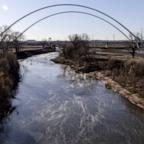Qualifications, Consistency Help Clinton, While Turnout Keeps Trump in the Hunt (POLL)
Advantages on qualifications and consistency are aiding Hillary Clinton.
— -- Advantages on qualifications and consistency and help from an increasingly popular incumbent are aiding Hillary Clinton in the presidential race -- but with weaknesses sufficient to keep Donald Trump well in the hunt in the campaign’s closing months.
Clinton has 46 percent support among likely voters in the latest ABC News/Washington Post poll, with 41 percent for Trump, 9 percent for Libertarian Gary Johnson and 2 percent for Jill Stein of the Green Party. Clinton’s 5-point advantage is within this poll’s margin of error, but it bears up in the context of consistent results among likely voters all summer.
See PDF with full results here.
Clinton takes a slight hit from the presence of Johnson and Stein; it’s a 51-43 percent contest (Clinton +8) in a two-way matchup with Trump alone. That occurs mainly because of defections by Bernie Sanders supporters: Clinton wins 94 percent of them one-on-one vs. Trump, but just 77 percent of them with Johnson and Stein in the mix.
Viewed another way, among Johnson and Stein supporters, Clinton leads Trump by 13 points in a two-way matchup (using August/September data for an adequate sample size).
Among groups, the poll finds a wide 21-point gender gap -- Trump +6 points among men, Clinton +15 among women, much more than the average gap (13 points) in exit polls dating to 1976. Trump’s chief strength is his 40-point lead among white men who lack a college education; Clinton’s is her 62-point advantage among nonwhites. His recent outreach notwithstanding, just 3 percent of blacks support Trump, as do 20 percent of Hispanics.
Behind Clinton’s single-digit advantage are wide double-digit expectations: Fifty-eight percent of Americans expect her to win the White House, vs. just 29 percent for Trump, a new low. Support for Johnson and Stein rises among those who expect a Clinton victory, suggesting that tamping down expectations is one strategy for Clinton to bolster her chances.
That’s especially so given the changeability of those who back Johnson or Stein; they’re far more apt than either Clinton or Trump supporters to say they might change their minds by Election Day. Just 15 percent of Clinton and Trump supporters say they could change their minds, vs. 55 percent of Johnson’s and Stein’s (among all adults, for an adequate sample).
Trump, for his part, enjoys greater strong enthusiasm among his supporters (12 points stronger than Clinton’s), potentially an aid in turnout. And turnout has an impact: The race tightens moving from all adults (Clinton +13 points in the four-way matchup) to registered voters (Clinton +10) to likely voters (Clinton +5).
This fits with longstanding greater propensity for Republican-leaning groups to register and vote. In one telling result, whites account for 74 percent of likely voters, vs. 65 percent of all adults. That matters because Trump leads among whites by 14 points in this poll, produced for ABC by Langer Research Associates.
Other notable results in this survey include Barack Obama’s approval rating, 58 percent, his best since the early days of his presidency, July 2009. That’s a boon to Clinton; among likely voters, eight in 10 Obama approvers back her for the presidency.
Dislikes and Likes
These results come in a contest in which the public finds plenty to dislike about both major party candidates. For example, a new low, just 35 percent of Americans, now see Clinton as honest and trustworthy, down from a high of 53 percent in June 2014. Her saving grace on this score is that slightly fewer, 31 percent, see Trump as honest and trustworthy.
They’re at near-parity on other criticisms as well. On one hand, 69 percent say Clinton is “too willing to bend the rules,” 62 percent (a new high) disapprove of her handling of questions about her private e-mail server, 57 percent are concerned about conflicts between a Clinton presidency and the work of the Clinton Foundation and 52 percent think she inappropriately did favors for foundation donors as secretary of state.
On the other: Sixty-five percent disapprove of the way Trump has been explaining his immigration policies (including a third of Republicans and four in 10 conservatives), 60 percent see him as biased against women and minorities and 60 percent are concerned about conflicts between a Trump presidency and his business interests.
There are some important attributes, though, on which Clinton prevails:
• Sixty percent of Americans see her as qualified for the presidency, while just 36 percent see Trump as qualified -- a key predictor of whether or not voters support him.
• While 53 percent say Clinton has been consistent in her positions on the issues, many fewer -- just 31 percent -- see Trump as consistent. Just 63 percent of Trump’s own supporters say their candidate has been consistent, vs. 87 percent among Clinton’s.
• Head-to-head, Clinton leads Trump by a wide margin on having the better personality and temperament to serve as president, 61-30 percent among all adults, and a still-wide 57-36 percent among likely voters.
The contest narrows on other head-to-head attributes. It’s Clinton +8 among likely voters on better understanding the problems of average Americans, +6 in being “closer to you on the issues” and about even, +2, in being more honest and trustworthy.
Clinton, further, is seen as less potentially damaging by her detractors than is Trump among his critics. Among likely voters who don’t support her, 69 percent think Clinton would do “real damage to the country” if elected. Among those who don’t support Trump, more, 80 percent, think he’d do real damage. (Similarly, 84 percent of likely voters who disapprove of Obama say he’s done real damage -- more on par with Trump than Clinton.)
Immigration
On the hot-button issue of immigration, the survey’s results indicate why Trump seemingly has been trying to recalibrate his position:
• Sixty-four percent of Americans say immigrants do more to strengthen than to weaken U.S. society, the most in three ABC/Post polls since July 2015.
• Given two stark choices, Americans overwhelmingly prefer offering undocumented immigrants a path to citizenship rather than deporting them all, 79-15 percent. That’s 62 percent even among Trump supporters.
• The public opposes building a wall across the full length of the Mexican border, 63-34 percent. And if Trump were to build such a wall, 76 percent disbelieve his claim he’d be able to get Mexico to pay for it -- including 42 percent of his supporters.
Regardless, just 8 percent of Americans pick immigration as the top issue in the election, and Clinton’s only even with Trump, 49-47 percent among likely voters, in trust to handle it. Her lead on specific immigration policies hasn’t translated into a general advantage on the issue.
Issues
Asked the top issue, 35 percent select the economy and jobs, followed by terrorism and national security (19 percent) and corruption in government (16 percent). Clinton leads Trump by 19 points among economy voters, while it’s Trump +13 among those focused on terrorism. Voters concerned with corruption divide more evenly.
Head-to-head, they’re fairly close on these issues -- anywhere from +2 to +9 points for Clinton among likely voters in trust to handle the economy, terrorism, immigration and taxes. On one other, Clinton vaults ahead: She’s got a 16-point advantage over Trump in trust to handle international trade agreements.
Groups
Vote preference results among some key groups include the wide gender and racial gaps, noted above. Among whites, moreover, Trump leads by 28 points among those who lack a college degree, while Clinton is +6 among college-educated whites. At the extremes, he leads by 40 points among non-college white men (a group Mitt Romney won by 31 points in 2012), while she leads by 10 among college-educated white women (a group Obama lost by 6).
With Labor Day past, ABC has moved to focusing vote-preference estimates on likely voters, who account for about 57 percent of all adults in this survey’s estimates. The survey also now asks the four-way matchup first, since that’s what most voters will see on their ballots.
This approach reflects that used by ABC/Post polls in some previous races with third-party candidates. In 2000, the final ABC/Post estimate had Ralph Nader at 3 percent and Pat Buchanan at 1 percent (They got 3 and 0.4 percent, respectively.) In 1996, we had Ross Perot at 7 percent; he got 8. And in 1992, we had Perot at 16 percent support; he got 19 percent.
What matters now for 2016 is not just current preferences but the underlying sentiments that inform them – views of the candidates’ issue positions, and, more notably this year, their qualifications and personal attributes. But in the end what’s crucial as well is turnout: In this poll, among registered voters who support Trump, 93 percent say they’re certain to vote. Among those who support Clinton, this declines to 80 percent. That -- plus Trump’s advantage in enthusiasm -- are among his best opportunities, and her main risks, in the two months ahead.
Methodology
This ABC News/Washington Post poll was conducted by landline and cellular telephone Sept. 5-8, 2016, in English and Spanish, among a random national sample of 1,002 adults, including 642 likely voters. Results have a margin of sampling error of 3.5 points, including the design effect, for the full sample, and 4.5 points for likely voters. Partisan divisions are 34-24-33 percent, Democrats-Republicans-independents, in the full sample, and 36-28-31 among likely voters.
The survey was produced for ABC News by Langer Research Associates of New York, N.Y., with sampling, data collection and tabulation by Abt-SRBI of New York, N.Y. See details on the survey’s methodology here.




